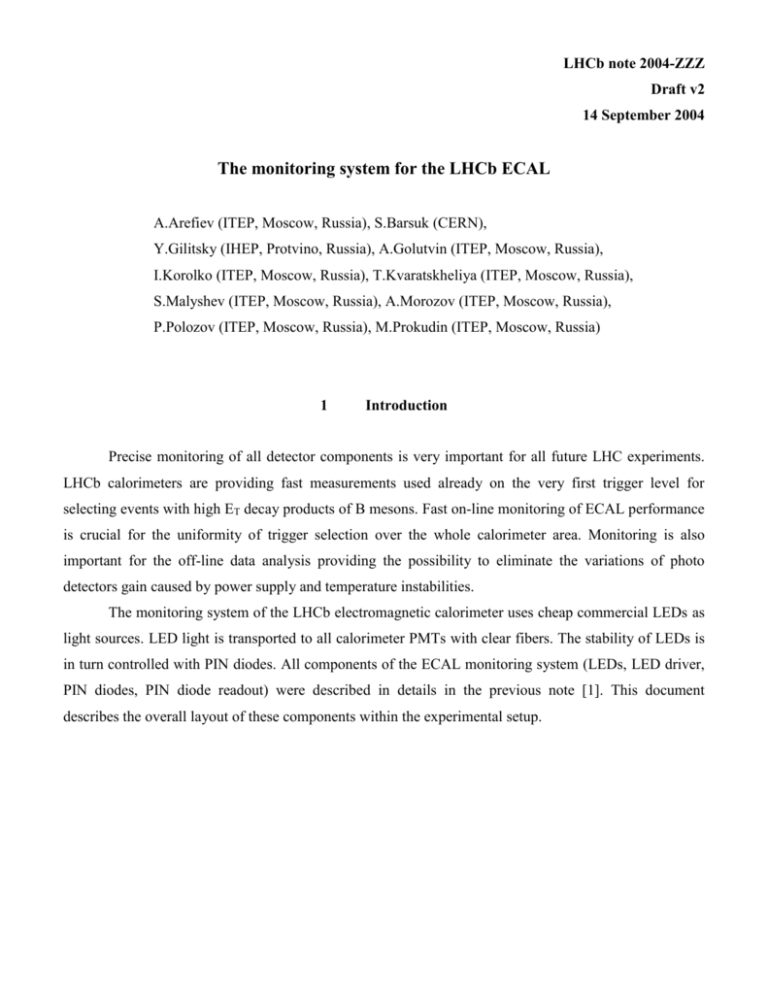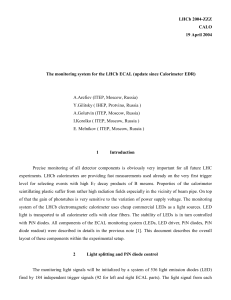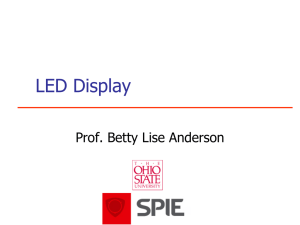document - Indico
advertisement

LHCb note 2004-ZZZ Draft v2 14 September 2004 The monitoring system for the LHCb ECAL A.Arefiev (ITEP, Moscow, Russia), S.Barsuk (CERN), Y.Gilitsky (IHEP, Protvino, Russia), A.Golutvin (ITEP, Moscow, Russia), I.Korolko (ITEP, Moscow, Russia), T.Kvaratskheliya (ITEP, Moscow, Russia), S.Malyshev (ITEP, Moscow, Russia), A.Morozov (ITEP, Moscow, Russia), P.Polozov (ITEP, Moscow, Russia), M.Prokudin (ITEP, Moscow, Russia) 1 Introduction Precise monitoring of all detector components is very important for all future LHC experiments. LHCb calorimeters are providing fast measurements used already on the very first trigger level for selecting events with high ET decay products of B mesons. Fast on-line monitoring of ECAL performance is crucial for the uniformity of trigger selection over the whole calorimeter area. Monitoring is also important for the off-line data analysis providing the possibility to eliminate the variations of photo detectors gain caused by power supply and temperature instabilities. The monitoring system of the LHCb electromagnetic calorimeter uses cheap commercial LEDs as light sources. LED light is transported to all calorimeter PMTs with clear fibers. The stability of LEDs is in turn controlled with PIN diodes. All components of the ECAL monitoring system (LEDs, LED driver, PIN diodes, PIN diode readout) were described in details in the previous note [1]. This document describes the overall layout of these components within the experimental setup. 2 Light splitting and PIN diode control The monitoring light signals will be initialized by a system of 456 light emission diodes (LED) fired by 456 independent trigger signals (228 for left and right ECAL parts). The light signal from each LED will be distributed to the front side of the modules using system of the optical splitters and clear optical transport fibers of 1,0 mm diameter. The light is transmitted from the transport fiber via an optical connector to another clear fiber of 1,2 mm diameter that penetrates each module cell and that is bundled in front of the PMT light mixer together with WLS fibers. For the inner calorimeter modules LED light is sent to 12 fibers – 9 transport fibers going to the modules front side and three fibers going to a reference PIN diode (including spare fibers). For middle and outer calorimeter modules LED light is split into 19 fibers – 16 transport fibers going to the modules front side and three fibers going to a reference PIN diode (including spare fibers). Several LEDs are controlled by a single PIN diode in order to minimize the total number of electronic channels used by the monitoring system. Figure 1 shows the groups of calorimeter cells flashed with a single LED for all ECAL sections. The same picture also illustrates the groups of neighbour LEDs controlled with a single PIN diode. Most of PIN diodes control 4 LEDs. The length of optical fiber bundles transporting the light from these LEDs to the calorimeter cells is different (~50 cm for the outer section). This difference will be compensated with a corresponding delay between LED trigger signals, which in turn will require a different length of clear fibers transporting the light to the reference PIN diode. Enlarged view of the inner ECAL section is presented in Figure 2. Each PIN diode in this section controls 4 LEDs. The difference in length of the corresponding optical fiber bundles is small (~12 cm) and therefore does not require special compensation. The whole monitoring system uses 128 PIN diodes. Table 1 presents the number of LEDs, PIN diodes and trigger signals for three sections of the LHCb electromagnetic calorimeter. Table 1 Monitoring system components for one half of ECAL Number of LEDs Number of PIN diodes Number of trigger signals Outer section 84 28 84 Middle section 56 14 56 Inner section 88 22 88 3 Optical fibers distribution system LEDs with light splitters, LED pulse drivers, reference PIN diodes and theirs readout are packed into the so-called light distribution boxes, located under the calorimeter platform and in a central region of electronics platform on top of the calorimeter. The central part of the upper ECAL wall (two 8 modules wide columns to the left and to the right from the calorimeter center) are serviced with two light distribution boxes located on top of the calorimeter, while the remaining calorimeter area is serviced with light distribution boxes located under the calorimeter supporting platform as shown in Figure 3. Eight light distribution boxes are located under the calorimeter – one box per 8 modules wide column. Table 2 summarizes the information about light distribution boxes for one half of the LHCb ECAL. The upper distribution box and two central boxes located under the calorimeter are 880 mm high and consist of two “floors” to house a large number of LEDs required for inner and middle ECAL sections. Two other boxes house relatively small number of LEDs monitoring the outer ECAL section and therefore do not require the second “floor”. Table 2 Light distribution boxes for one half of the calorimeter. XYZ size (mm) Number of LEDs Number of PIN diodes Upper box 720 x 880 x 120 60 17 1st lower box 720 x 880 x 120 60 17 2nd lower box 720 x 880 x 120 56 16 3rd lower box 624 x 500 x 120 26 7 4th lower box 624 x 500 x 120 26 7 All clear fibers lighten by a single LED, are grouped in a bundle, which is mechanically and optically protected with a heat shrinkable tube (heated only in a few places for fixation). All bundles from the light distribution boxes are passed through the thin gap between calorimeter and preshower supporting structures uniformly in one layer. Reaching the calorimeter, bundles are grouped in vertical plastic trays attached to the calorimeter surface. Plastic trays transport fiber bundles to the required groups of calorimeter modules. Then individual fibers, protected with smaller diameter heat shrinkable tubes, are connected to the corresponding ECAL cells. 4 Light distribution boxes A schematic view of the light distribution box fragment is shown in Figure 4 for four monitoring LEDs. The box has 2 layers (in Z direction). First layer is used for the arrangement of fiber bundles. The second layer hosts the main components of the monitoring system – LEDs, LED drivers, light splitters and PIN diodes with their readout. All LEDs controlled with a single PIN diode are located together just in front of the controlling PIN diode. Fibers transporting the light from LEDs to PIN diodes are also placed in the second layer. Figure 5 shows the layout of LEDs and PIN diodes in the central box located under the calorimeter platform. Single LED together with light splitter occupies 20x140 mm2. PIN amplifier boards occupy 40x100 mm2 and are located on the 140 mm distance from the LED drivers. Each light distribution box has to be equipped with: common power for LED drivers (+5 V, +25V) common power for PIN diode boards (+/-6 V, +25 V) corresponding number of trigger signals from trigger signal boards corresponding number of LED amplitude control voltages from HV distribution boards 5 LED pulse driver LED driver is based on a low cost monolithic interface circuit DS0026 from National Semiconductors. Unique circuit design provides both very high speed operation and the ability to drive large capacitive loads (up to 1000 pF). The device accepts standard TTL signals and converts them to levels up to 20V. The DS0026 circuit is intended for applications where the output pulse width is logically controlled, i.e. output pulse width is equal to the input pulse width. Rise and fall times measured values were obtained about 5 nsec each at 20V supply voltage. The device has two high current complementary output bipolar junction transistors with no current limited resistors in chain, that provides high output current drive up to 1,5 Amps. The DS0026 has low power consumption about 2 mW in zero state. During the LED’s monitoring system prototype beam test at CERN, the DS0026 input signal was used for the LED pulse shape adjustment as close as possible to the electron signal pulse shape. Adjustment of the LED’s light amount was realized by supply voltage level matching. In 2004 the DS0026 chip has become obsolete (but still available from the distributors). We have therefore found 4 analogous chips (EL7104 and EL7212 from the Intersil, SN75372 from Texas Instruments and ICL7667 from Harris Corporation). El7212 which is pin to pin compatible with DS0026 was successfully tested during this summer test beam period. Principal scheme of LED driver based on EL7104 chip is shown in Figure 6. Photo of the LED driver is presented in Figure 7. 6 PIN diode board The photodiode is mounted on a printed circuit board together with the two stage amplifier, principal readout scheme is shown in Figure 8. The first stage is a preamplifier, the second one is a shaper. The main idea of the two stage amplifier solution is to use time constant of the input pole of transfer function (CpinRin) for the preamplifier output pulse shape adjustment close to the photomultiplier pulse shape (Figure 9). The shaper stage is using for the clipping implementation and range matching with the standard CROC. The PIN diode output signal simulated by PSpice is shown in Figure 10. For both stages low noise wideband operational amplifiers LMH6624 are using. The LMH6624 has input noise density 0,92nV/(sqrt Hz) that is close to special designed low noise amplifiers. Estimated equivalent noise charge of the readout chain is about 5000 electrons at the 50 MHz gain bandwidth. Taking into account the difference between PMT Hamamatsu R7899-20 and PIN diode quantum efficiency for red light, the equivalent noise energy for the PIN diode readout chain is about hundred MeV. The maximal LED light pulse corresponds few hundreds GeV for the innermost calorimeter modules that provides 12 bits dynamic range in the PIN diode readout chain. PIN amplifier board was produced this year and successfully tested during test beam period. Photo is shown in Figure 11. This board has additional possibility to use bi-polar transistor as heard element which allows the flexible twisted-pair connection of PIN diode to the amplifier board using “cold” termination. References [1] Y.Gilitsky et al., LHCb2003-151 (internal note) Figure 1 Light splitting scheme and LED grouping for all ECAL sections. First digit represents the section number (1-outer, 2-middle, 3-inner). PiN diode number within the given section is given after the dot. Figure 2 Light splitting scheme and LED grouping for inner ECAL section. Figure 3 Layout of 4 light distribution boxes under the ECAL platform. Figure 4 Fragment of the light distribution box (schematic view). Figure 5 Schematic view of the central light distribution box, located under the ECAL platform. Digital code shown for LED drivers corresponds to the scheme presented in Figure 1 and Figure 2. Red arrows illustrate the fibers transmitting the LED light to PiN diodes. Figure 6 Principal scheme of the LED driver. Figure 7 Preproduction prototype of LED driver. PCB dimensions are 15x100 mm2. Figure 8 Principal scheme of the PIN diode readout. Figure 9 PSpice simulation of the input signal. Figure 10 PSpice simulation of the output signal. Figure 11 Preproduction prototype of PIN diode board. PCB dimensions are 40x100 mm2.





![Introduction [max 1 pg]](http://s3.studylib.net/store/data/007168054_1-d63441680c3a2b0b41ae7f89ed2aefb8-300x300.png)
